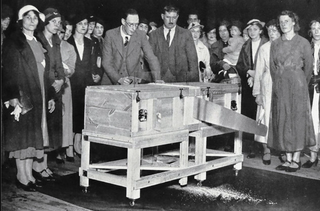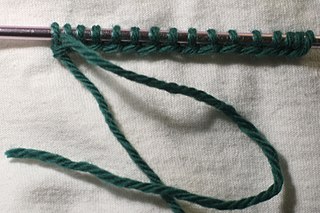Related Research Articles

The bassoon is a woodwind instrument in the double reed family that plays music written in the bass and tenor clefs, and occasionally the treble. Appearing in its modern form in the 19th century, the bassoon figures prominently in orchestral, concert band, and chamber music literature. It is known for its distinctive tone colour, wide range, variety of character, and agility. The modern bassoon exists in two forms; Buffet and Heckel systems. One who plays a bassoon of either system is called a bassoonist.

The Balducci levitation is a levitation illusion first described by Ed Balducci. Its inventor is unknown. It is an impromptu magic trick, which has been popularized by many magicians, such as David Roth, Paul Harris, and David Blaine.

Polydactyly or polydactylism, also known as hyperdactyly, is an anomaly in humans and animals resulting in supernumerary fingers and/or toes. Polydactyly is the opposite of oligodactyly.

The cups and balls is a performance of magic with innumerable adaptations. Street gambling variations performed by conmen we known as Bunco Booths. A typical cups and balls routine includes many of the most fundamental effects of magic: the balls can vanish, appear, transpose, reappear and transform. Basic skills, such as misdirection, manual dexterity, sleight of hand, and audience management are also essential to most cups and balls routines. As a result, mastery of the cups and balls is considered by many as the litmus test of a magician's skill with gimmick style tricks. Magician John Mulholland wrote that Harry Houdini had expressed the opinion that no one could be considered an accomplished magician until he had mastered the cups and balls. Professor Hoffman called the cups and balls "the groundwork of all legerdemain".

Steven John Kilbey is an English-Australian singer-songwriter and bass guitarist for the rock band The Church. He is also a music producer, poet, and painter. As of October 2014, Kilbey had 750 original songs registered with Australian copyright agency Australasian Performing Right Association (APRA).

Coin magic is the manipulating of coins to entertain audiences. Because coins are small, most coin tricks are considered close-up magic or table magic, as the audience must be close to the performer to see the effects. Though stage conjurers generally do not use coin effects, coin magic is sometimes performed onstage using large coins. In a different type of performance setting, a close-up coin magician will use a large video projector so the audience can see the magic on a big screen. Coin magic is generally considered harder to master than other close-up techniques such as card magic, as it requires great skill and grace to perform convincingly, and this requires much practice to acquire.
A trick deck usually refers to a deck of playing cards that has been altered in some way to allow magicians to perform certain card tricks where sleight of hand would be too difficult or impractical.

Sawing a woman in half is a generic name for a number of stage magic tricks in which a person is apparently sawn or divided into two or more pieces.

Cigar boxes are rectangular props used in juggling. Cigar box manipulation began as a vaudeville act in the United States between the 1880s and 1920s, and was popularized by W. C. Fields. Originally, performers would take actual boxes that cigars were stored in and nail them shut to create their juggling props. Today, cigar boxes for juggling are typically purpose-built, hollow wooden or plastic blocks with suede or foam rubber padding attached to the sides.
Paul Kieve is an English professional illusionist and whose consulting work for both stage and screen has contributed to changing how magical special effects in productions are approached. He is the only illusionist ever to have won a New York Drama Desk award. He created the illusions for the 2014 Kate Bush concert Before the Dawn.

A thumb tip is a magician's prop designed to fit over and appear to be the magician's thumb used for vanishing, producing, or switching small objects. A classic effect is to have a silk handkerchief or other small object pressed into the top of the left fist. After pushing it well in with the right thumb, the left fist is opened to show the silk has disappeared. Alternatively, a lit cigarette, liquid, salt or other small objects can be made to disappear in a similar manner.
This is a glossary of conjuring terms used by magicians.
David Copperfield has performed a levitation illusion in several magic shows since 1992 in which he appears to fly on stage for several minutes, while surrounded by audience members. The flight is notable for its graceful motion and unencumbered appearance. The illusion was included in Copperfield's CBS TV special The Magic of David Copperfield XIV: Flying—Live The Dream (1992), and has been repeated several times during Copperfield's live tours around the world. The method was created by John Gaughan. An essential contribution to make fluid movements was given by his assistant, dancer and choreographer Joanie Spina.

Baton twirling is an art involving the manipulation of a metal rod and the performer's body to a coordinated routine. It is similar to rhythmic gymnastics or color guard.

In knitting, casting on is a family of techniques for adding new stitches that do not depend on earlier stitches, i.e., having an independent lower edge. In principle, it is the opposite of binding off, but the techniques involved are generally unrelated.

The Tarbell Course in Magic is a notable encyclopedia of magic amongst professional and amateur magicians. It has eight volumes; the first five were part of the original home-study correspondence course compiled in 1928 by Dr. Harlan Tarbell, the remaining three volumes being added on later.

Magic, which encompasses the subgenres of illusion, stage magic, and close up magic, is a performing art in which audiences are entertained by tricks or illusions of seemingly impossible feats using natural means. It is to be distinguished from paranormal magic which are effects claimed to be created through supernatural means. It is one of the oldest performing arts in the world.

The aerial suspension, ethereal suspension or broomstick illusion is an illusion in which the performer appears to be suspended in mid-air for some minutes, with either inadequate support or no apparent support of his or her weight. This trick was first recorded in India in the early 19th century.

A levitation illusion is one in which a magician appears to defy gravity by making an object or person float in the air. The subject may appear to levitate unassisted, or it may be performed with the aid of another object in which case it is termed a "suspension".
